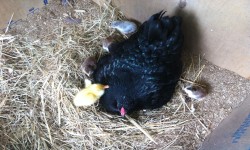
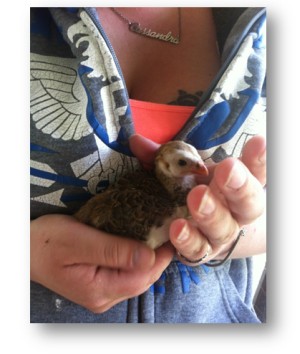
How to raise Guinea fowl keets is necessary as it’s a bit different from raising chickens. OK, so who knows what a keet is? Ever heard of Guinea Fowl? Yes? No?
Let me take you on a fascinating journey into the world of the unknown (at least to quite a few of you) and let me share with you interesting and pertinent information concerning these unusual birds.
Keets are Guinea Fowl young… like duck with ducklings; hens with chickens! They are delightful little creatures and as they grow they provide you with endless entertainment.
I’d love to share with you my journey into a new realm, one I have enjoyed each step of the way!
Further info:
- How to Raise Guinea Fowl Keets (up to 8 weeks old) – this page!
- Care for Guinea Fowl Facts – Part 2 (facts and features)
- Care for Guinea Fowl Facts – Part 3 (facts and stories) – coming
My Story
As a friend of ours (Alan) knew I wanted to raise some Guinea Fowl, he appeared at our place one day holding a box of a dozen Guinea Fowl eggs, with the idea of placing them under one of my broody hens! I’d been having a number of my chooks go broody on me, but unfortunately only the day before I had managed to take one off the brood. Now what was I going to do?
Finding a suitable mum
He told me I had a window of roughly 10 days so I decided to wait and see what happened. Would you believe it that one of my chooks became broody in the 11th hour… just before the 10 day window had expired! Yes!
As I had been using 3 of them as encouragement for my ducks to lay, I had 9 left, so I placed them under her (White Feather), and threw in a few duck eggs as well as they take the same time to hatch. So I thought, why not?
I had moved her, eggs and all, to a more suitable spot in the enclosure where she was safe… and then she and I began to wait.
Hen in waiting – let’s candle the eggs!
About a week into the sitting I decided to try my hand at ‘candling the eggs’ to see if there was any action taking place. I took the eggs into a very dark place and with the use of a strong torch shining behind the eggs, I could see or not see, if there were any young developing. But, I couldn’t see anything so I then tried testing them using tepid water, but the results didn’t tell me much.
Oh dear, I thought… there’s nothing there. I was so disappointed. The reality is that I gave up expecting anything out of this brood. It decided to leave White Feather to do her job though as she was very determined! (Mind you, I’ve since learned you need to wait for at least 2 weeks before running the tests. Well we live and learn, don’t we?)
As you can see she’s a fully black chook with only about 4 teeny white feathers on her head. Can you see them?
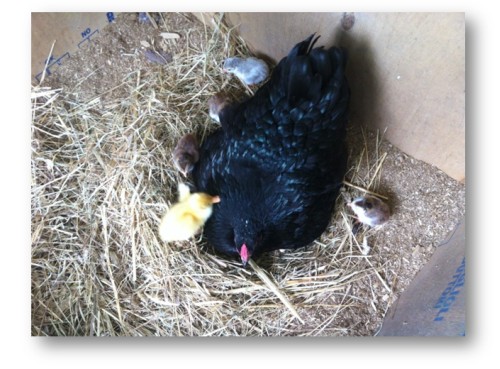
Confinement over…
My son Trent always lets the birds out of their enclosures each morning, and one morning he came rushing over to the homestead saying he could hear quite a bit of noise going on in the box.
Really?
I ran down there as fast as my legs would carry me, ducked into the enclosure and lifted the lid of the box. Oh, if only I had taken my camera with me, because right there were 7 keets and 1 little duckling all staring up at me. I couldn’t believe my eyes!
When I called Alan & Sue to tell them the “good news”, they were amazed at our success. They reckoned that getting 7 our of 9 potentials was an extremely good ratio. Yay!
It was quite funny really, as I felt like a mum who was just told to bring her baby home but had done nothing to prepare. What to do?
Week 1
Anyway, I left them in that box for a few days until it became evident that they could get out, and who knows what could happen. So off we went to purchase a little rabbit hutch, which after assembling, we placed it on some grass nearby our back deck.
It worked quite well. Each day I’d move the cage and give them more water and feed, and provided them with nice fresh straw. White Feather seemed to understand that the cage was keeping her babies from harm so there were no problems. The keets are so tiny at this stage. You need to be very careful with water as they can drown. I used only the shallow tray on this feeder, but even that I half filled with pebbles. I changed their water a couple of times a day to keep it fresh as the duckling was always dirtying the water.
Heavy Losses
It’s at this age that keets born “in the wild” with their natural mothers tend to experience heavy losses.
I’ve been told that guinea hens don’t like to lay in the pens as they are wild birds at heart.
This means they will find somewhere out on the property… which potentially means they could come to harm.
What could harm Guinea Fowl Keets
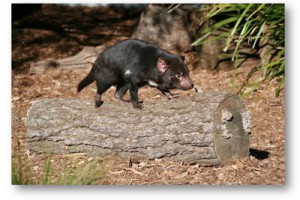 Here in Tasmania our two main worries are Tasmanian Devils and Quolls – a wild cat. Although we have never seen any evidence of their presence on our property, it doesn’t mean they are not around.
Here in Tasmania our two main worries are Tasmanian Devils and Quolls – a wild cat. Although we have never seen any evidence of their presence on our property, it doesn’t mean they are not around.
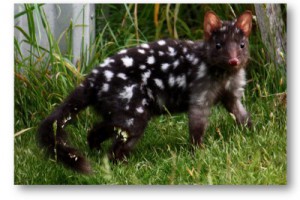
Some of the other birds seeing the babies for the very first time. They were totally fascinated!
See how large the duckling was in comparison to the keets. Right from the beginning she dabbled her beak in the dirt and then in the water. Just like a duck!
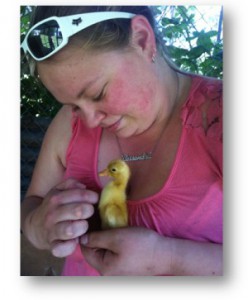
Well, the rabbit hutch had quite a short life span for these birds, as by the time the little keets were only 2 weeks old, they were fully feathered and flying! It was really amazing. Here they were flying around inside this little rabbit hutch… bonk into the wire sides, and all.
Meanwhile, the little duckling or “Little Duckie” as I called her, was covered in yellow down and not a white feather in site. Oh my goodness! Time to rethink the plan. What to do?
I went back over to the cage where they were hatched and thought about what I could do. Trouble was, these large cages were originally dog kennels and they had quite large and very strong wire netting around them. I knew if I put the keets in there they would simply fly out through the netting. What to do? What to do?
Ahh… I came up with an idea! We had some white bird netting, you know the type you put over gardens or fruit trees to keep birds away. So for the next two solid days, I worked away at surrounding one of the enclosures with this white netting. A big job.
Week 2
You will see in this video how I covered the whole enclosure using the bird netting. I’ve left it there until this day because I don’t know when I may need it again.
Week 3
Hear that sound White Feather is making. This was talking to her little ones and keeping them nearby. That’s a great thing of-course, but it also worked against me. I would have loved to nurse them all and get them used to my touch but she wouldn’t have any of that. Just as soon as I tried to make contact she’d call them under her wings. I did get to touch them but nowhere near enough unfortunately.
This tells me that if you wish to really tame your keets down, it would be better for them to be raised in an incubator. That way you wouldn’t have a fussy ol’ hen calling them to her whenever you tried to touch them. Having said that, I think White Feather did a marvellous job. It was her first time and she just “knew” what to do. The wonder of nature.
Week 4
I was always very aware that they lived on a concrete floor. I mean, back in the rabbit hutch they lived on the lawn and White Feather taught them to eat the grass and how to look for other inviting insects etc. So each day I tried to supplement their diet with extra goodies. I must say the peas were a roaring success!
Week 5
I’d also pick big handfuls of different grasses that were in seed, and tie them to the cage. This way they could pull against them and therefore get little pieces, or seeds, they could swallow. I did that for 6 weeks all up.
Week 6
Five weeks old and growing up! I’m keeping them all still in the enclosure until they are a full 8 weeks old. This is to make sure that when they are released they are strong enough, and big enough, to at least have a fair go at looking after themselves.
I can’t be completely sure of the parents of “Little Duckie”. Now I know who the father is – that’s Toby our big white drake, but there are two ducks which are identical, apart from a bit of colour on their beaks. Never-the-less, I couldn’t possibly know which one laid the egg. Since she’s been out I’ve told her that she has the beak of her father, they are identical, but the voice of her mother! As you would most probably know, drakes don’t quack, but have quite a soft sound. Meanwhile, the ducks can be very loud if they decide to be.
Week 7
See how I tied the grasses to the cage. Actually, it’s tied to a stick that’s crossing the corner of the cage.
Week 8
The day has finally arrived! Yay!
I went over later in the afternoon, maybe about 5pm and opened the door. This is because it’s not that long before they will start thinking of their bed. I suppose they had about an hour and a half outside with mum. None of the others caused them any trouble or harm, and when the sun set they all followed mum back into the enclosure. I was so happy!
I took a few extra days to introduce them to the outside world, each day just adding another hour. Then in the end I let them outside at the same time as all the other birds, and they simply followed mum wherever she went.
White Feather was more than ready to leave the enclosure a few weeks before. She was drastically missing all her bugs and delights, but that would have caused mayhem if I’d let her out. As you can see, they are a pretty good size now.
Since that day…
When the time came that White Feather decided it was time they started being more independent, the keets were really quite upset about it. It didn’t take White Feather very long to decide Little Duckie belonged with the other ducks, so she drove her off.
Not fun! 🙁
There was a time when Little Duckie was all by herself as she just wasn’t ready to get too involved with the other ducks.
But now that mum was starting to drive off the keets, they turned to Little Duckie. She became their mother for a couple of weeks. Wherever she went, they would follow, as at this stage she had not ventured to the dam. Eventually they became more independent as they matured.
Now Little Duckie is equally as happy with the keets, chooks or ducks… and they all love her. Her day is spent dividing her time fairly equally between the keets and chooks, and the ducks on the dam.
Do you have any questions? Please leave them down below and I’ll be happy to answer them within about 24 hours. If you also have experience with keets, please leave a comment and tell us. I’m hoping that if you are considering, or thinking about how to raise guinea fowl keets, that when you read this article and view the videos you will be quite encouraged to do so.
Warm regards,
Marilyn Williams
![]()








Hi Marilyn,
Thanks for all your info. My situation is a bit different from yours. I don’t have a mother chicken hen but I do have 2 female young guineas that I got when they were probably 3-4 months old. just I think they’re just under a year old now. I had 3 other guineas but a fox got to them. I’d like to raise more guineas and this time start when they’re 2 weeks old. And raise them with chicks. How much room do the keets need before they get to move into their coop? How long do I keep the heat lamp? 4 weeks? I live in the northeast, upstate New York so the temperatures right now range anywhere from above freezing to 75 F. Thanks for your help.
Hi Lauren!
I’ll have a go at answering your questions although I’m not sure regarding the heat lamp etc. Where I live there was no need for any of that as of-course, mother hen took care of their warmth needs.
My keets were free after about 9 weeks. At hardly more than 1 week old they were flying around much to the disgust of the little duckling that was raised with them… she still had yellow fluff!
Now, at 9 weeds old, when I let them all out of the coop for an hour or so, then building until I left them out all day long as I felt confident, they were still very dependent on mum. Once mum shooed them off, as chickens do, they treated the duckling as their mum. The duckling outgrew the keets in size so I guess that’s why they transferred over to her. She took the job very seriously.
Gradually they became more independent and able to care for themselves, although they always remained very close to the duck.
As I said, roomwise, they tend to start flying extremely early so you will need enough room to cater for that. I guess the need for a heat lamp will totally depend on how cold it is… if you find they are huddling near it, keep it going… if preferring to sit away from it… maybe time to turn it off.
I’m thrilled you love your guineas… I certainly do… what fascinating little creatures!
HI!!! Marilyn my name is james, I lov raiseing Guinea fowl. The problem I have living inow south Louisiana is humidity. I have better luck running my incubator dry. This is the only way I can control the humidity at 56% to 65% temp at 99.5 to 100. On day 25 I stop an remove Turner. Then add two small wet sponges this raises my humidity to 80% then lock it’s lock down. If I need more humidity I wet the sponges with syringe through the vent hole on top of incubator.This way I have about 80% to 90% hatch. Right now I have42 Guinea eggs in incubator. And. Three broody hens with each 12 Guinea eggs. Everything is due 5 days apart.I have 5 laying pairs. Anot I love eating the eggs. I sell the adults at 4 mouths old. I have the gray pearl jumbo. P.S I enjoyed ready all your comments & veditos Thanks for sharing James
Hi James! Wow, you are into it in a big way aren’t you? I’ve never tried the incubator way as you know I have used one of my chicken hens to do the job for me. At least I don’t have to control the temperature so that’s a plus for me. I think your idea of raising and selling them at 4 months is a great idea. I do hope the amount you make on them more than sufficiently covers the cost of raising them… I think it certainly should.
The eggs are exquisite aren’t they… they are my favourite between guinea, duck and chicken… love ’em! I would love to hear how you get on… please feel free to keep in contact so we can share notes. Marilyn
Hi Marilyn!
I’m so happy that your poultry are flourishing! We live on a 2 1/2 acre property and have chickens, a dog and a cat and added to our family yesterday, 5-week old keets! We have wanted them for ages as a friend next door has a flock of 20.They run around all over the place including onto the road! We have to get out of the car and shoo them back to the sides! They are the funniest animals I have ever encountered.
As we have the 2 new keets (one male and one female) we have concerns that when they grow up and we let them out, that they will join the other flock next door. Will this be a problem?
Hi Samantha! You have certainly just started an exciting journey! You will find that they will be teaching you a lot as you go, and I agree with you they are the funniest birds ever. I love them, and I love their ways… they are a law unto themselves and very strong in nature.
You will need to keep them penned up for some time. Mine were 8 weeks old when they were let out of the pen but they had been there for at least 7 of the eights weeks. I wouldn’t let your birds out before at least 8 weeks old which would give them 3 weeks to accept the pen as home to return to each night.
Guineas can really fly wherever they want to go… up, up and away… but really, they don’t choose to! As they are growing… let’s say up until about 6 months, they will startle easily at anything moving and this can cause them to fly up… and in my case, this meant that sometimes when they landed they were on the other side of the fence. But I have always found they only have one thing in mind once landing on the other side of the fence… they want to be back in where they should be!
We only have typical farm fences so ours could go off and away at any time, but that typical farm fence is like a complete barrier to them when they are on the wrong side of it. They don’t seem to comprehend that they flew over it and could just as easily fly back. No… they run up and down on foot for hours complaining they can’t find their way back. So be warned.
Will they join the flock next door is a hard question to answer. As long as the two you’ve got pair up (become true mates) I don’t think they would. I’ve only got 8 (4 boys and 4 girls – 4 mated pairs) and although they spend some time together, generally speaking they are wandering around our property as 4 separate pairs.
I’d love to hear how you are getting on… please let me know.
Warm regards, Marilyn
We are moving to a farm and my husband wanted these birds as “watch dogs.” Being from the city, I had no idea what they were. We bought 2 and raised them with 6 chick!s I kept looking for info online about raising them and thought they were like chickens. They’re not! My biggest surprise was that they need a flock. So we bought 3 more that were smaller than the first 2. Was trying to find a good site to give me not only information, but also pictures of the different stages.
I’m enjoying raising them; however, your site is giving me great information – especially about feeding and handling.
Your stories provided this for me. My main concern was what to feed them. We had bought medicated chick feed thinking they would eat the same thing as the chicks. Thanks for your assistance. I look forward to my keets continuing to grow. I try to hold them everyday, but the bigger ones don’t like it so much anymore. They are just beginning to get their waddles (? I think that’s what it’s called). The younger ones are maybe 2 week old.
You also cleared up for me the one keet
Hi Penny… I’m so glad you’re into guinea fowls! You know, the longer you have them, the more you appreciate them. They are fantastic little birds with their own little ways.
You are quite right… I don’t think I mentioned a thing about the feed, so I must do that. I was advised to feed them wild game starter and then finisher when they were older. As you see, I raised mine with a mother chicken hen and she only ate whatever I gave them. I let them out with the rest of the flock when they were just 8 weeks old and when the current bag of feed ran out I just fed them the same as the chickens.
Since then, and a lot of growing since, I now feed them a mixture of whole seeds, the same as I’m giving my chickens. They let me know if they are not impressed with their meal… they throw it around as if looking for something they like. I was giving them ground up feed but they were quite unhappy. When I started the mixture mentioned above it was like Christmas to them… chirp, chirp, chirp!
I don’t believe the chickens are quite as fussy as them, but they sure know what they like, and what they don’t.
Yes, they are definitely a flock bird but I find my eight guineas seem to be quite content. You’ll find as your birds grow they’ll have a lot of sorting out to do between themselves but mine co-habitate together with the hens and ducks and all’s well.
I’d love to know how you get on with them… and if you have any questions please don’t hesitate to ask. Marilyn
Didn’t the duckling want to go to water? You said you had them locked up for 8 weeks.
Well yes she did want water and I’m sure she wondered why none of her siblings didn’t want to come into the dish along with her! I provided a dish that pretty much looked after her desire for water… she loved it.
It seems really strange to me that you used a chicken to be the mom of the keets! But, a I read, it all seemed to work out really well. Congrats on that because that’s something I’d never think to do. Mervyn
Yes Mervyn, it didn’t prove to be a problem at all… in fact they say that chicken’s make much better mothers than the guinea fowl does. Guinea Fowls are extremely quick… they run very fast so that the little ones can’t possibly keep up. Also, if they decide to cross water they simply fly across but the little ones have to try to wade across… not good. The chicken would never do any of those things as she is very protective and caring.
Thanks for the comment. Marilyn
i love the sound of these cool little birds. i don’t think i could keep any where i live because of council laws but it’s good to read and learn about them anyway. one day i hope to see some – maybe at a zoo?
It’s a shame you can’t have any of your own – I understand that. They can be quite noisy at times. Most of the day you don’t hear a thing but I’ve noticed of late that they like to call out loudly just before settling down to bed. I guess you could find some at a zoo… in fact, I’m sure you could. Never looked myself but I’m sure you would find some. Thanks for sharing.
Growing up in the Philippines, we had and raised chicken. It’s just one of the countries that didn’t have too much draconian laws on animal ownership. Hahaha…lots of drama between the White Feather and the other fowls at the end, I have no doubt it probably wasn’t fun dealing with that. I’d like to raise animals somebody, hopefully on my own property.
Hi Lakan… if you do get the chance to raise some of your own on your very own property, I’m sure you will really enjoy it. Try to tune into the birds and to understand what they are wanting/saying to you as this will increase your enjoyment so much! All the best.
Growing up in the Philippines, we had and raised chicken. It’s just one of the countries that didn’t have too much draconian laws on animal ownership. Hahaha…lots of drama between the White Feather and the other fowls at the end, I have no doubt it probably wasn’t fun dealing with that. I’d like to raise animals somebody, hopefully on my own property.
Hi Lakan… if you do get the chance to raise some of your own on your very own property, I’m sure you will really enjoy it. Try to tune into the birds and to understand what they are wanting/saying to you as this will increase your enjoyment so much! All the best.
I wish I had the space to raise some animals but living in a rental it just isn’t possible.
When I was a kid we had chickens, pigs, and rabbits. My job was to feed and water them.
Our neighbor however had guinea hens and peacocks. Boy were those birds loud. The guinea hens made a ruckus all day long and the peacocks would scream like a woman in distress. I was happy we only had one noisy rooster to deal with.
Gary
share-a-like dot com
You made me smile asI read your comment. Yes that’s the problems with rentals – can’t make your own choices. Of-course neighbours can also dictate choices. We also considered getting some geese but reading online convinced me they may be too loud for both neighbours and us. It’s definitely the female guinea fowl who make the most consistant annoying sound. A screaming woman does not sound too good!
Thanks for your input
Great article Marilyn! I love the detail that you put into writing this. The videos are an awesome touch, I never would’ve known how cute those little guys are without watching a few of them! Like some of your other readers I have a couple friends and family members that raise chickens but this is a whole new and interesting world.
Keep up the good work.
Thanks Trevor! Yes, they really are very cute when they’re young. I’m glad you not only liked what you read but you learned some new and interesting facts as well. That’s cool. Maybe you may see it in the real if one of your family members decide to go down that track.
Greetings, Marilyn! What an interesting presentation. Being originally from a large American city of 4.4 million, I have no idea what a “guinea fowl keet” is, nor do I know what a “chook” is and I barely know what a “duck” is…just kidding on the last one. lol
I think you have done a great job of chronicling the birth and growth of these wild birds and made it quite interesting to me, a regular “city folk”; however, I’m not sure I would have stayed at the beginning without a very good motivation. I believe you might consider building up an introduction to what you are about to do for the reader. Tell us you are going to take us on a journey that most people in the world will never experience (I think that is true) and we will be delighted (I was). Your videos were a pleasure. You did a good job! Hats off to you. Now, what do you do with those birds eventually? …into the wild? …or into the freezer? Reality, right? PapaDave
Oh you are telling me how I could improve the introduction to the story… well you know what, I took on board what you said and hopefully did improve a little. Thank you.
Looking ahead it’s a little difficult to say exactly what will happen… especially when the females come into lay. I’m just hoping we can collect those eggs and life will continue as normal.
They would never be released back into the wild unless that’s what they choose. I could never stop them if they wanted to go. But when they first looked up from their containing shell, they saw a hen. She was mum. Ever since then I think they all think they are chooks and therefore pretty much do whatever the chooks do. They spend all day with the chooks and sometimes all the birds spend time together. They seem very contented with their lot.
Into the freezer!?!? Oh no! I’m not a farm girl and the thought of lopping their heads off is worse than worse. They are my friends, so how on earth could I turn around and kill them. I wouldn’t kill Rocky the dog, so why would I kill them? Perish the thought!
Having said that, I believe they do make very good eating… quite a delicacy I’m to understand. Maybe one day I’ll try one at a restaurant, who knows.
No, they have a job to do which is eating every bug, tick and insect they can find. From what I understand, they are better than the other birds at this job. And apparently they drive off snakes! I like that. Haven’t seen it yet but haven’t seen a snake neither.
Thanks for coming by. I’m guessing you’re not about to take up guinea fowl raising… but you found it interesting never-the-less. For that I’m thankful.
Hi there Marilyn,
That was a delightful post. I have never had the opportunity to raise fowl and I never realized how much was involved in trying to raise them.
I loved watching them from the egg stage all the way up to when they were released.
Do raise all of your own fowl or is this the first time you had ever tried this?
Thank you again for sharing this. I learned so much.
Hi Val… having these birds is a pure joy to me. All that’s involved in looking after them I enjoy because I enjoy them so much. They give me as much as I give them.
This was my first time raising keets although we did raise our own chooks years ago. I’m hesitating to do anymore at this stage as we currently have 23 birds which feels quite enough. It’s not like we are a farm… it’s just a hobby for me and they provide us with many fresh eggs to enjoy.
The chooks are always telling me they want to be a mum, in fact while White Feather was on the nest nearly all the other 5 chooks went broody. (This means they wanted to sit on eggs to bring forth young). I had to say no and take steps to bring them out of the brood.
Thanks you for coming and taking interest in what I’m doing. Remember to come again. 🙂
Hi Marwil,
I did get a kick out of the birds checking out the new “aliens” lol. You seem to be right where your passion is concerning these little critters! By what I can see, they are all in good hands. It’s cool to see that the adoption process isn’t strictly a human trait!
No, adoption is alive and well in the bird kingdom… at least with my chooks. I don’t know how I’d get on if I put chook eggs under a duck – I bet she’d expect them to swim. It was only a last minute thought putting the duck eggs under the chook… not one I’m sure I’d do another time. Still and all, she turned out with a wonderful nature, and very caring about her siblings – the keets!
I’m so glad I captured the moment when the chooks saw the babies for the first time… it was a wonderful moment.
Thanks for sharing your enjoyment of the article with us.
Well, this is something new. I actually found myself wanting to read more and more about them and Whitefeather, it’s like a story of its own! Loved your writing style, like I said before, it’s a narrative on its own and quite attention gripping too.
Also, it drops a lot of hints/tips and tricks into raising a unique animal, sometimes it looks simple, other times it requires a bit of extra care.
I’m really pleased you found the story interesting as I hope others will too along the way. If they are considering these birds for their own property I tried to give them something to work on… and to understand a little of what’s involved. To me, everything was new so it was a total learning process.
Thanks for taking the time to leave your thoughts… and come back again as I have another one in the making.
Marilyn really cool story and I really like all the videos you have in the post.
I have a few friends that have chickens and hens, but looks like you know much more about it then them!
I really didn’t know much about it, but I learned a ton in this post about it.
Thanks for sharing this story!
Brok
What I know Brok comes from experience. Not great experience… but never-the-less, experience. As each week passed I took a video each Sunday which was their weekly birthday. I thought to myself I may need this and here it is.
I’m glad you’ve had the opportunity to learn something new even if for reasons, best known to yourself, you can’t have those experiences.
Thanks for leaving your thoughts anyway – it’s really cool.